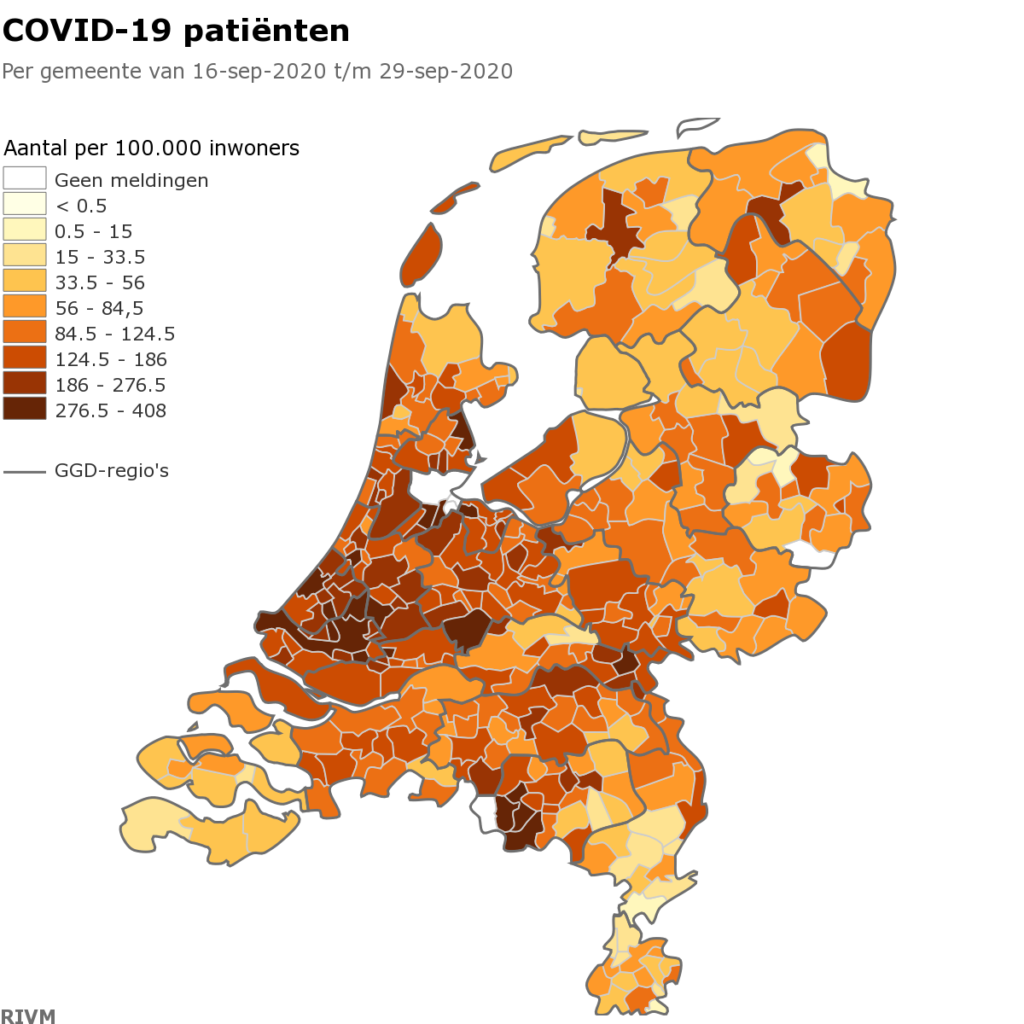As the Netherlands prepares to implement a new round of coronavirus measures, the second wave of coronavirus has continued to grow ferociously.
In the past week, 19,326 new infections were recorded by the RIVM, over 40% higher than the previous week’s numbers. These figures are likely to actually be higher due to the backlog of testing at GGDs. 244 patients have been hospitalised this week, up from 152 the previous week.
Sadly, deaths in the past week have suffered an alarming jump. While 33 people were confirmed dead in the week prior, this week’s death count rose to 102.
The following map from the RIVM shows how hard each region in the Netherlands has been hit.
New national measures announced last night
Prime Minister Rutte made it clear at last night’s press conference, that the new coronavirus measures, which will be in effect from 6 PM this evening, need to be taken seriously. Both private and public group gatherings have been drastically reduced, catering services must be closed from 10 PM, and cabinet has urgently advised people to work from home as much as possible. If infection rates do not adequately improve in the next three weeks, we may be facing another ‘intelligent lockdown’.
Although masks have not been made a national requirement, Amsterdam, Rotterdam, The Hague and Eindhoven have strongly advised people to wear masks in public spaces.
Dutch infections amongst the worst in western Europe
In a study which compared 950 regions in western Europe, Amsterdam clocked in with the 6th highest infection rate, closely behind Paris and Brussels. Overall, the 40 Dutch regions are performing terribly as well, coming in way above the average numbers of other countries. Most notably, Germany and Ireland have performed very well. Their detailed, fast, and thorough measures have been praised as the reason for this.
Tourism industry in the Netherlands suffers
Before the pandemic, the Netherlands was expecting to welcome around 21 million tourists this year. The reality is now expected to be about a third of that. Many large events were planned for 2020, and there were high hopes for a bustling tourist scene in many major Dutch cities. But of course, these events were all cancelled, and tourism numbers have returned to those of the 90s.
But it’s not just international tourism that has dropped, Dutchies are choosing not to holiday in the Netherlands either this year. NBTC director Jos Vranken does not expect the tourism industry to recover until 2024. He stresses the need for government to support the industry during this time.
Rapid testing trial in Utrecht
This week, we saw a trial testing street go up in Utrecht, which will compare the effectivity of rapid coronavirus tests compared to the regular tests. PRC tests, which are normally used, can take around five hours to wield a result, but the rapid tests should take only around 15 minutes. If these tests prove reliable, it will greatly aid the GGDs which are struggling to keep up with the increasing testing demand, which will only increase as winter approaches and the second wave continues.
Belgium goes orange
The orange-risk status of some regions in Belgium has now been declared for the entire country by Dutch cabinet, following Belgium’s decision to classify parts of the Netherlands as red. This means that Dutch residents are only advised to travel to Belgium if it is absolutely necessary. If you do cross the border and intend to stay for 48 hours or more, you will need to take a coronavirus test.
Follow DutchReview on Facebook for more coronavirus updates.
Image: ©Geber86/Canva.com



